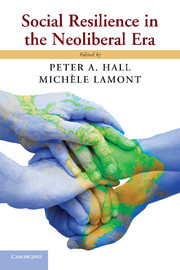Book contents
- Frontmatter
- Contents
- Contributors
- Foreword
- Prologue
- Acknowledgments
- Introduction
- Part I Neoliberalism
- Part II The Social Sources of Individual Resilience
- Part III Social Resilience on a Macro Scale
- PART IV Communities and Organizations as Sites for Social Resilience
- 9 Neoliberalism in Québec
- 10 Can Communities Succeed When States Fail Them?
- 11 Cultural Sources of Institutional Resilience
- 12 The Origins and Dynamics of Organizational Resilience
- Index
- References
9 - Neoliberalism in Québec
The Response of a Small Nation Under Pressure
Published online by Cambridge University Press: 05 May 2013
- Frontmatter
- Contents
- Contributors
- Foreword
- Prologue
- Acknowledgments
- Introduction
- Part I Neoliberalism
- Part II The Social Sources of Individual Resilience
- Part III Social Resilience on a Macro Scale
- PART IV Communities and Organizations as Sites for Social Resilience
- 9 Neoliberalism in Québec
- 10 Can Communities Succeed When States Fail Them?
- 11 Cultural Sources of Institutional Resilience
- 12 The Origins and Dynamics of Organizational Resilience
- Index
- References
Summary
Introduction
The general question that drives this analysis of Québec relates to the capacity – or lack thereof – of a society to recover after a trauma or to face a serious challenge that can threaten its very foundations, cultural as well as material. In keeping with the focus of this book, I will use the concept of resilience to denote the capacity of a society to cope with a challenge or a “shock.” For a society, this can be achieved in at least three ways: (a) by successfully opposing and resisting the external assault in such a way as to return to the former state (or “equilibrium”); (b) by adapting to the new situation through adjustment, negotiation, and compromise; and (3) by seizing on the occasion to respond creatively to the challenge and to reinvent oneself through major innovations and progressive changes – in other words, to thrive in adversity and, in the process, “do better than expected” (see Chapter 5; Cyrulnik 1999). In each of these scenarios, through different strategies, the society energetically reacts and manages to maintain its basic institutions and to restore its ways of life. Accordingly, one could talk of three forms of resilience: conservative, adaptive, and progressive. It follows that a nonresilient society will flatly renounce or fail to fight for its primary ideals and goals, for the institutional setting that they inform, and for its ways of life. It will also prove to be unable to take advantage of the new context.
It should be understood that the response can be orchestrated at the local or community level as well as at the macro-social and national level by individual and collective actors. Yet, at the micro level, the perspective differs insofar as a particular social group or category of citizens is less likely to bring about major societal changes. A progressive form of resilience at this level may consist in a redefinition of the interactions of that group with its social environment. Therefore, as shown by the literature in this field, one must be aware of the variety of forms resilience can assume and the variety of ways it can be pursued. That encourages prudent utilization of this highly polysemous concept.
- Type
- Chapter
- Information
- Social Resilience in the Neoliberal Era , pp. 267 - 292Publisher: Cambridge University PressPrint publication year: 2013
References
- 11
- Cited by

